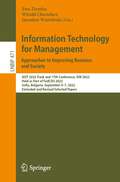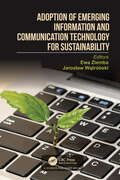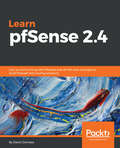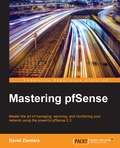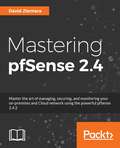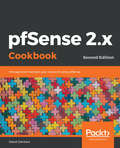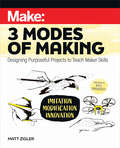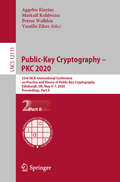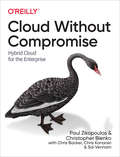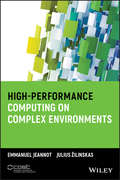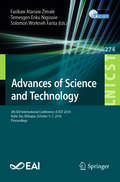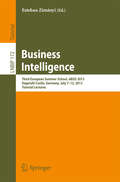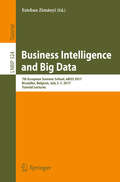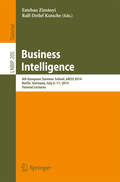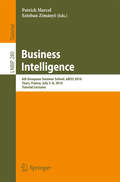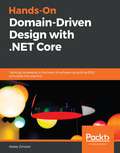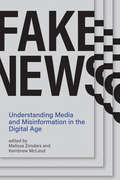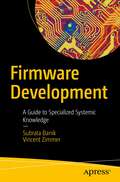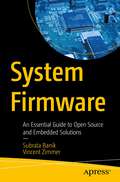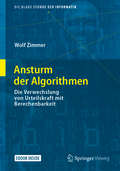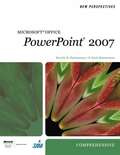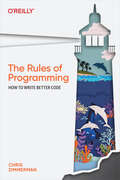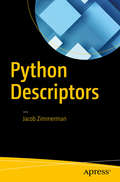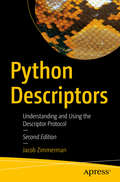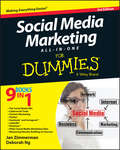- Table View
- List View
Information Technology for Management: AIST 2022 Track and 17th Conference, ISM 2022, Held as Part of FedCSIS 2022, Sofia, Bulgaria, September 4–7, 2022, Extended and Revised Selected Papers (Lecture Notes in Business Information Processing #471)
by Ewa Ziemba Witold Chmielarz Jarosław WątróbskiThis book constitutes revised selected and extended papers presented at track 4 of the Conference on Computer Science and Intelligence Systems, FedCSIS 2022, which took place in Sofia, Bulgaria, during September 4–7, 2022.The FedCSIS Information Systems and Technologies Track included AIST 2022, ISM 2022, DSH 2022, and KAM 2022. AIST 2022 received 11 submissions, from which 2 full papers and 1 short paper have been accepted; for ISM 2022 2 full and 3 short papers have been accepted from 15 submissions; and for DSH 2022 2 full and 1 short papers have been accepted from 11 submissions. From the 17 submissions to KAM 2022, no paper passed the extended reviews, so the overall acceptance rate was 20% for full and 18% for short papers. The papers were organized in topical sections named: Approaches to improving business; approaches to improving society; and methods for improving business and society.
Adoption of Emerging Information and Communication Technology for Sustainability
by Ewa Ziemba JarosławThis book represents an important voice in the discourse on the adoption of emerging ICT for sustainability. It focuses on how emerging ICT acts as a crucial enabler of sustainability, offering new forward-looking approaches to this field. The book explores how emerging ICT adoption drives sustainability efforts in business and public organizations, promoting ecological, economic, social, cultural, and political sustainability. The book's theoretical discussions, conceptual approaches, empirical studies, diverse perspectives, and views make it a valuable and comprehensive reference work. Appealing to both researchers and practitioners, this book provides significant areas for research and practice related to the contribution of emerging ICT adoption to sustainability. It also suggests vital considerations for programming and building sustainable development-driven emerging ICT adoption. Readers will find answers to important contemporary questions, such as: What are the concepts, frameworks, models, and approaches to enhance sustainable development through the adoption of emerging ICT? How does the adoption of emerging ICT influence sustainability? How can emerging ICT be adopted to enhance sustainability? What are the current practices and successful cases of emerging ICT adoption for sustainability? What factors influence emerging ICT adoption to enhance sustainability?
Learn pfSense 2.4: Get up and running with Pfsense and all the core concepts to build firewall and routing solutions
by David ZientaraInstall, Configure and Setup different connections with pfSenseKey FeaturesBuild firewall and routing solutions with PfSense.Learn how to create captive portals, how to connect Pfsense to your https environment and so on.Practical approach towards building firewall solutions for your organizationBook DescriptionAs computer networks become ubiquitous, it has become increasingly important to both secure and optimize our networks. pfSense, an open-source router/firewall, provides an easy, cost-effective way of achieving this – and this book explains how to install and configure pfSense in such a way that even a networking beginner can successfully deploy and use pfSense.This book begins by covering networking fundamentals, deployment scenarios, and hardware sizing guidelines, as well as how to install pfSense. The book then covers configuration of basic services such as DHCP, DNS, and captive portal and VLAN configuration. Careful consideration is given to the core firewall functionality of pfSense, and how to set up firewall rules and traffic shaping. Finally, the book covers the basics of VPNs, multi-WAN setups, routing and bridging, and how to perform diagnostics and troubleshooting on a network.What you will learnInstall pfSenseConfigure additional interfaces, and enable and configure DHCPUnderstand Captive portalUnderstand firewalls and NAT, and traffic shapingLearn in detail about VPNsUnderstand Multi-WANLearn about routing and bridging in detailUnderstand the basics of diagnostics and troubleshooting networksWho this book is forThis book is towards any network security professionals who want to get introduced to the world of firewalls and network configurations using Pfsense. No knowledge of PfSense is required
Mastering pfSense
by David ZientaraMaster the art of managing, securing, and monitoring your network using the powerful pfSense 2.3 About This Book * You can always do more to secure your software - so extend and customize your pfSense firewall * Build a high availability security system that's fault tolerant - and capable of blocking any threats * Put the principles of better security into practice - unlock a more stable and reliable firewall Who This Book Is For SysAdmins and security pros - get more from the world's leading firewall with this book. You can always do more to secure your software, so start here. What You Will Learn * Configure pfSense services such as DHCP, Dynamic DNS, captive portal, DNS, NTP and SNMP * Set up a managed switch to work with VLANs * Use pfSense to allow, block and deny traffic * Make use of the traffic shaper to lower and raise the priority of certain types of traffic * Set up and connect to a VPN tunnel with pfSense * Incorporate redundancy and high availability by utilizing load balancing and the Common Address Redundancy Protocol (CARP) * Explore diagnostic tools in pfSense to solve network problems In Detail pfSense has the same reliability and stability as even the most popular commercial firewall offerings on the market - but, like the very best open-source software, it doesn't limit you. You're in control - you can exploit and customize pfSense around your security needs. If you're familiar with pfSense you probably knew that already. This book builds on any knowledge you may already have, and provides you with a clear route to expand your skills and pfSense's capabilities. You'll learn how to customize and configure pfSense to construct a firewall that can protect you from any potential security threats. Find out how to set up a VPN, and build a high-availability system that provides redundancy and fault tolerance - essential when security and software performance are so interdependent. With further guidance on how to use a diverse range of third-party packages - all of which will help you unlock more from pfSense, this book covers everything you need - and more - to get a high-quality, reliable firewall up and running for a fraction of the cost. Style and approach Practical and actionable, tackle some advanced functionalities of pfSense with minimum fuss. We know you don't just want an instruction manual - you want to put the principles of better security into practice. That's exactly why we produced this book.
Mastering pfSense,: Manage, secure, and monitor your on-premise and cloud network with pfSense 2.4, 2nd Edition
by David ZientaraInstall and configure a pfSense router/firewall, and become a pfSense expert in the process.Key FeaturesYou can always do more to secure your software – so extend and customize your pfSense firewallBuild a high availability security system that’s fault-tolerant – and capable of blocking potential threatsPut the principles of better security into practice by implementing examples provided in the textBook DescriptionpfSense has the same reliability and stability as even the most popular commercial firewall offerings on the market – but, like the very best open-source software, it doesn’t limit you. You’re in control – you can exploit and customize pfSense around your security needs.Mastering pfSense - Second Edition, covers features that have long been part of pfSense such as captive portal, VLANs, traffic shaping, VPNs, load balancing, Common Address Redundancy Protocol (CARP), multi-WAN, and routing. It also covers features that have been added with the release of 2.4, such as support for ZFS partitions and OpenVPN 2.4. This book takes into account the fact that, in order to support increased cryptographic loads, pfSense version 2.5 will require a CPU that supports AES-NI. The second edition of this book places more of an emphasis on the practical side of utilizing pfSense than the previous edition, and, as a result, more examples are provided which show in step-by-step fashion how to implement many features.What you will learnConfigure pfSense services such as DHCP, Dynamic DNS, captive portal, DNS, NTP and SNMPSet up a managed switch to work with VLANsUse pfSense to allow, block and deny traffic, and to implement Network Address Translation (NAT)Make use of the traffic shaper to lower and raise the priority of certain types of trafficSet up and connect to a VPN tunnel with pfSenseIncorporate redundancy and high availability by utilizing load balancing and the Common Address Redundancy Protocol (CARP)Explore diagnostic tools in pfSense to solve network problemsWho this book is forThis book is for those with at least an intermediate understanding of networking. Prior knowledge of pfSense would be helpful but is not required.Those who have the resources to set up a pfSense firewall, either in a real or virtual environment, will especially benefit, as they will be able to follow along with the examples in the book.
pfSense 2.x Cookbook - Second Edition: Manage and maintain your network using pfSense, 2nd Edition
by David ZientaraThis book is intended for all levels of network administrators. If you are an advanced user of pfSense, then you can flip to a particular recipe and quickly accomplish the task at hand, while if you are new to pfSense, you can read chapter by chapter and learn all of the features of the system from the ground up.
Make: Three Modes of Making
by Matt ZiglerThe Maker movement has been an excellent opportunity for people to become producers rather than just consumers, and schools are recognizing the value of offering students the tools, materials, and skills necessary to design sophisticated and meaningful projects. But teaching technical skills should not be the end goal: At its best, a Maker education teaches students to think and act in creative ways that can be applied to difficult challenges in all areas of life.Three Modes of Making provides a framework for Maker courses in upper grades that teach students creative-process skills through three key Maker modes: Imitation, Modification, and Innovation. Educators will learn the differences between the three Maker modes, their associated skill sets, and gain concrete methods to teach, document, and assess these skills. Through this approach, teachers will enable students to apply them to different creative needs.By focusing on how to teach skill development rather than merely how to build specific objects, Three Modes of Making enables students to improve and enhance their creative skills, and learn ways to apply them to a wide variety of challenges. This book is a road map to developing the creative problem solvers that the world needs for the future.
Public-Key Cryptography – PKC 2020: 23rd IACR International Conference on Practice and Theory of Public-Key Cryptography, Edinburgh, UK, May 4–7, 2020, Proceedings, Part II (Lecture Notes in Computer Science #12111)
by Vassilis Zikas Aggelos Kiayias Markulf Kohlweiss Petros WalldenThe two-volume set LNCS 12110 and 12111 constitutes the refereed proceedings of the 23rd IACR International Conference on the Practice and Theory of Public-Key Cryptography, PKC 2020, held in Edinburgh, UK, in May 2020. The 44 full papers presented were carefully reviewed and selected from 180 submissions. They are organized in topical sections such as: functional encryption; identity-based encryption; obfuscation and applications; encryption schemes; secure channels; basic primitives with special properties; proofs and arguments; lattice-based cryptography; isogeny-based cryptography; multiparty protocols; secure computation and related primitives; post-quantum primitives; and privacy-preserving schemes.
Cloud Without Compromise
by Paul Zikopoulos Christopher Bienko Chris Backer Chris Konarski Sai VennamMany companies claim to have "gone to the cloud," yet returns from their efforts are meager or worse. Why? Because they've defined cloud as a destination, not a capability. Using cloud as a single-vendor, one-stop destination is fiction; in practice, today's organizations use a mosaic of capabilities across several vendors. Your cloud strategy needs to follow a hybrid multicloud model, one that delivers cloud's value at destinations you choose.This practical guide provides business leaders and C-level executives with guidance and insights across a wide range of cloud-related topics, such as distributed cloud, microservices, and other open source solutions for strengthening operations. You'll apply in-the-field best practices and lessons learned as you define your hybrid cloud strategy and drive your company's transformation strategy.Learn cloud fundamentals and patterns, including basic concepts and historyGet a framework for cloud acumen phases to value-plot your cloud futureKnow which questions to ask a cloud provider before you signDiscover potential pitfalls for everything from the true cost of a cloud solution to adopting open source the right way
High-Performance Computing on Complex Environments
by Julius Zilinskas Emmanuel Jeannot* Covers cutting-edge research in HPC on complex environments, following an international collaboration of members of the ComplexHPC * Explains how to efficiently exploit heterogeneous and hierarchical architectures and distributed systems* Twenty-three chapters and over 100 illustrations cover domains such as numerical analysis, communication and storage, applications, GPUs and accelerators, and energy efficiency
Advances of Science and Technology: 6th EAI International Conference, ICAST 2018, Bahir Dar, Ethiopia, October 5-7, 2018, Proceedings (Lecture Notes of the Institute for Computer Sciences, Social Informatics and Telecommunications Engineering #274)
by Fasikaw Atanaw Zimale Temesgen Enku Nigussie Solomon Workneh FantaThis book constitutes the refereed post-conference proceedings of the 6th International Conference on Advancement of Science and Technology, ICAST 2018, which took place in Bahir Dar, Ethiopia, in October 2018. The 47 revised full papers were carefully reviewed and selected from 71 submissions. The papers present economic and technologic developments in modern societies in five tracks: agro-processing industries for sustainable development, water resources development for the shared vision in blue Nile basin, IT and computer technology innovation, recent advances in electrical and computer engineering, progresses in product design and system optimization.
Business Intelligence: Third European Summer School, eBISS 2013, Dagstuhl Castle, Germany, July 7-12, 2013, Tutorial Lectures (Lecture Notes in Business Information Processing #172)
by Esteban ZimányiTo large organizations, business intelligence (BI) promises the capability of collecting and analyzing internal and external data to generate knowledge and value, thus providing decision support at the strategic, tactical, and operational levels. BI is now impacted by the "Big Data" phenomena and the evolution of society and users. In particular, BI applications must cope with additional heterogeneous (often Web-based) sources, e. g. , from social networks, blogs, competitors', suppliers', or distributors' data, governmental or NGO-based analysis and papers, or from research publications. In addition, they must be able to provide their results also on mobile devices, taking into account location-based or time-based environmental data. The lectures held at the Third European Business Intelligence Summer School (eBISS), which are presented here in an extended and refined format, cover not only established BI and BPM technologies, but extend into innovative aspects that are important in this new environment and for novel applications, e. g. , pattern and process mining, business semantics, Linked Open Data, and large-scale data management and analysis. Combining papers by leading researchers in the field, this volume equips the reader with the state-of-the-art background necessary for creating the future of BI. It also provides the reader with an excellent basis and many pointers for further research in this growing field.
Business Intelligence and Big Data: 7th European Summer School, eBISS 2017, Bruxelles, Belgium, July 2–7, 2017, Tutorial Lectures (Lecture Notes in Business Information Processing #324)
by Esteban ZimányiThis book constitutes revised tutorial lectures of the 7th European Business Intelligence and Big Data Summer School, eBISS 2017, held in Bruxelles, Belgium, in July 2017. The tutorials were given by renowned experts and covered advanced aspects of business intelligence and big data. This summer school, presented by leading researchers in the field, represented an opportunity for postgraduate students to equip themselves with the theoretical, practical, and collaboration skills necessary for developing challenging business intelligence applications.
Business Intelligence: 4th European Summer School, eBISS 2014, Berlin, Germany, July 6-11, 2014, Tutorial Lectures (Lecture Notes in Business Information Processing #205)
by Esteban Zimányi Ralf-Detlef KutscheThis book constitutes the tutorial lectures of the 4th European Business Intelligence Summer School, eBISS 2014, held in Berlin, Germany, in July 2014. The tutorials presented here in an extended and refined format were given by renowned experts and cover topics including requirements engineering for decision-support systems, visual analytics of large data sets, linked data and semantic technologies, supervised classification on data streams, and knowledge reuse in large organizations.
Business Intelligence: 6th European Summer School, eBISS 2016, Tours, France, July 3-8, 2016, Tutorial Lectures (Lecture Notes in Business Information Processing #280)
by Esteban Zimányi Patrick MarcelBusiness Intelligence (BI) promises an organization the capability of collecting and analyzing internal and external data to generate knowledge and value, providing decision support at the strategic, tactical, and operational levels. Business Intelligence is now impacted by the Big Data phenomena and the evolution of society and users, and needs to take into account high-level semantics, reasoning about unstructured and structured data, and to provide a simplified access and better understanding of diverse BI tools accessible trough mobile devices. In particular, BI applications must cope with additional heterogeneous (often Web-based) sources, e. g. , from social networks, blogs, competitors', suppliers', or distributors' data, governmental or NGO-based analysis and papers, or from research publications. The lectures held at the First European Business Intelligence Summer School (eBISS), which are presented here in an extended and refined format, cover not only established BI technologies like data warehouses, OLAP query processing, or performance issues, but extend into new aspects that are important in this new environment and for novel applications, e. g. , semantic technologies, social network analysis and graphs, services, large-scale management, or collaborative decision making. Combining papers by leading researchers in the field, this volume will equip the reader with the state-of-the-art background necessary for inventing the future of BI. It will also provide the reader with an excellent basis and many pointers for further research in this growing field.
Hands-On Domain-Driven Design with .NET Core: Tackling complexity in the heart of software by putting DDD principles into practice
by Alexey ZimarevSolve complex business problems by understanding users better, finding the right problem to solve, and building lean event-driven systems to give your customers what they really wantKey FeaturesApply DDD principles using modern tools such as EventStorming, Event Sourcing, and CQRSLearn how DDD applies directly to various architectural styles such as REST, reactive systems, and microservicesEmpower teams to work flexibly with improved services and decoupled interactionsBook DescriptionDevelopers across the world are rapidly adopting DDD principles to deliver powerful results when writing software that deals with complex business requirements. This book will guide you in involving business stakeholders when choosing the software you are planning to build for them. By figuring out the temporal nature of behavior-driven domain models, you will be able to build leaner, more agile, and modular systems.You’ll begin by uncovering domain complexity and learn how to capture the behavioral aspects of the domain language. You will then learn about EventStorming and advance to creating a new project in .NET Core 2.1; you’ll also and write some code to transfer your events from sticky notes to C#. The book will show you how to use aggregates to handle commands and produce events. As you progress, you’ll get to grips with Bounded Contexts, Context Map, Event Sourcing, and CQRS. After translating domain models into executable C# code, you will create a frontend for your application using Vue.js. In addition to this, you’ll learn how to refactor your code and cover event versioning and migration essentials.By the end of this DDD book, you will have gained the confidence to implement the DDD approach in your organization and be able to explore new techniques that complement what you’ve learned from the book.What you will learnDiscover and resolve domain complexity together with business stakeholdersAvoid common pitfalls when creating the domain modelStudy the concept of Bounded Context and aggregateDesign and build temporal models based on behavior and not only dataExplore benefits and drawbacks of Event SourcingGet acquainted with CQRS and to-the-point read models with projectionsPractice building one-way flow UI with Vue.jsUnderstand how a task-based UI conforms to DDD principlesWho this book is forThis book is for .NET developers who have an intermediate level understanding of C#, and for those who seek to deliver value, not just write code. Intermediate level of competence in JavaScript will be helpful to follow the UI chapters.
Fake News: Understanding Media and Misinformation in the Digital Age (Information Policy)
by Melissa Zimdars Kembrew McLeodNew perspectives on the misinformation ecosystem that is the production and circulation of fake news.What is fake news? Is it an item on Breitbart, an article in The Onion, an outright falsehood disseminated via Russian bot, or a catchphrase used by a politician to discredit a story he doesn't like? This book examines the real fake news: the constant flow of purposefully crafted, sensational, emotionally charged, misleading or totally fabricated information that mimics the form of mainstream news. Rather than viewing fake news through a single lens, the book maps the various kinds of misinformation through several different disciplinary perspectives, taking into account the overlapping contexts of politics, technology, and journalism.The contributors consider topics including fake news as “disorganized” propaganda; folkloric falsehood in the “Pizzagate” conspiracy; native advertising as counterfeit news; the limitations of regulatory reform and technological solutionism; Reddit's enabling of fake news; the psychological mechanisms by which people make sense of information; and the evolution of fake news in America. A section on media hoaxes and satire features an oral history of and an interview with prankster-activists the Yes Men, famous for parodies that reveal hidden truths. Finally, contributors consider possible solutions to the complex problem of fake news—ways to mitigate its spread, to teach students to find factually accurate information, and to go beyond fact-checking.ContributorsMark Andrejevic, Benjamin Burroughs, Nicholas Bowman, Mark Brewin, Elizabeth Cohen, Colin Doty, Dan Faltesek, Johan Farkas, Cherian George, Tarleton Gillespie, Dawn R. Gilpin, Gina Giotta, Theodore Glasser, Amanda Ann Klein, Paul Levinson, Adrienne Massanari, Sophia A. McClennen, Kembrew McLeod, Panagiotis Takis Metaxas, Paul Mihailidis, Benjamin Peters, Whitney Phillips, Victor Pickard, Danielle Polage, Stephanie Ricker Schulte, Leslie-Jean Thornton, Anita Varma, Claire Wardle, Melissa Zimdars, Sheng Zou
Firmware Development: A Guide to Specialized Systemic Knowledge
by Vincent Zimmer Subrata BanikBuild your own system firmware. This book helps you understand system firmware architecture and minimalistic design, and provides a specialized knowledge of firmware development. The book includes guidance on understanding the system firmware build procedure, integrating pieces of firmware and allowing configuration, updating system firmware, creating a development infrastructure for allowing multi-party collaboration in firmware development, and gaining advanced system firmware debugging knowledge.After reading the book you will be able to assume better control while developing your own firmware and know how to interact with native hardware while debugging. You will understand key principles for future firmware development using newer technology, and be ready for the introduction of modern safe programming languages for firmware development. Detailed system firmware development case studies using a futuristic approach cover:Future scalable system firmware development modelsTypes of firmware development (system firmware, device firmware, manageability firmware)Tools and their usage while creating system firmwareHow to build infrastructure for seamless firmware development using a multi-party development modelDebugging methodologies used during various phases of firmware product developmentSetting up key expectations for future firmware, including thinner firmware footprints and faster execution time, easier configuration, and increased transparent security What You Will LearnUnderstand the system firmware working model of the futureGain knowledge to say goodbye to proprietary firmware for different types of firmware developmentKnow the different types of tools required for creating firmware source code before flashing the final image into the boot device of the embedded systemDevelop skills to understand the failure in firmware or in the system and prepare the debugging environment to root cause the defectsDiscern the platform minimal security requirementOptimize the system firmware boot time based on the target hardware requirementComprehend the product development cycle using open source firmware development Who This Book Is For Embedded firmware and software engineers migrating the product development from closed source firmware to open source firmware for product adaptation needs as well as engineers working for open source firmware development. A secondary audience includes engineers working on various bootloaders such as open source firmware, UEFI, and Slim Bootloader development, as well as undergraduate and graduate students working on developing firmware skill sets.
System Firmware: An Essential Guide to Open Source and Embedded Solutions
by Vincent Zimmer Subrata BanikFind the right bootloader solution or combination of firmware required to boot a platform considering its security, product features, and optimized boot solutions. This book covers system boot firmware, focusing on real-world firmware migration from closed source to open source adaptation. The book provides an architectural overview of popular boot firmware. This includes both closed sourced and/or open source in nature, such as Unified Extensible Firmware Interface (UEFI), coreboot, and Slim Bootloader and their applicable market segments based on product development and deployment requirements. Traditional system firmware is often complex and closed sourced whereas modern firmware is still a kind of hybrid between closed and open source. But what might a future firmware model look like? The most simplistic boot firmware solution uses open source firmware development. This book helps you decide how to choose the right boot firmware for your products and develop your own boot firmware using open source. Coverage includes: Why open source firmware is used over closed sourceThe pros and cons of closed and open source firmwareA hybrid work model: for faster bring-up activity using closed source, binary integrated with open source firmware What You Will LearnUnderstand the architecture of standard and popular boot firmwarePick the correct bootloader for your required target hardwareDesign a hybrid workflow model for the latest chipset platformUnderstand popular payload architectures and offerings for embedded systemsSelect the right payload for your bootloader solution to boot to the operating systemOptimize the system firmware boot time based on your target hardware requirementKnow the product development cycle using open source firmware developmentWho This Book Is For Embedded firmware and software engineers migrating the product development from closed source firmware to open source firmware for product adaptation needs as well as engineers working for open source firmware development. A secondary audience includes engineers working on various bootloaders such as open source firmware, UEFI, and Slim Bootloader development, as well as undergraduate and graduate students working on developing firmware skill sets.
Ansturm der Algorithmen: Die Verwechslung von Urteilskraft mit Berechenbarkeit (Die blaue Stunde der Informatik)
by Wolf ZimmerDer durch die „Blumenkinder“ des Silicon Valley entfesselte digitale Rausch droht, die Vernunft durch den Aberglauben zu ersetzen, man könne die Welt rechnend vervollkommnen. Wer aber glaubt, die Probleme einer ungewissen Welt mit technologischen Gewissheiten lösen zu können, hat weder etwas von der Welt noch etwas von der Technologie verstanden. Im digitalen Sittenbild aus Silizium und Statistik ersetzt Rechnen das Denken, Wahrscheinlichkeit wird für Wahrheit ausgegeben und Korrelation verdrängt Kausalität. Die Hohepriester der Digitalisierung fragen nicht, ob wir das, was sie verkünden, für gut und richtig halten. Gut und richtig sind keine Kategorien des Digitalen.
New Perspectives on Microsoft® Office PowerPoint® 2007: Comprehensive
by Beverly B. Zimmerman S. Scott ZimmermanFollowing the critical thinking, problem-solving approach of the New Perspectives Series learners will gain a comprehensive understanding of Microsoft PowerPoint 2007, including the new features of the software. The case-based tutorials challenge learners to apply what they are learning to real-life tasks, preparing them to easily transfer skills to new situations. With the New Perspectives Series approach, learners understand why they're learning what they're learning, and are better situated to retain skills.
The Rules of Programming
by Chris ZimmermanThis philosophy-of-programming guide presents a unique and entertaining take on how to think about programming. A collection of 21 pragmatic rules, each presented in a standalone chapter, captures the essential wisdom that every freshly minted programmer needs to know and provides thought-provoking insights for more seasoned programmers. Author Chris Zimmerman, cofounder of the video game studio Sucker Punch Productions, teaches basic truths of programming by wrapping them in memorable aphorisms and driving them home with examples drawn from real code. This practical guide also helps managers looking for ways to train new team members. The rules in this book include: As simple as possible, but no simplerLet your code tell its own storyLocalize complexityGeneralization takes three examplesWork backward from your result, not forward from your codeThe first lesson of optimization is don't optimizeA good name is the best documentationBugs are contagiousEliminate failure casesCode that isn't running doesn't workSometimes you just need to hammer the nails
Python Descriptors
by Jacob ZimmermanThis short book on Python descriptors is a collection of knowledge and ideas from many sources on dealing with and creating descriptors. And, after going through the things all descriptors have in common, the author explores ideas that have multiple ways of being implemented as well as completely new ideas never seen elsewhere before. This truly is a comprehensive guide to creating Python descriptors. As a bonus: A pip install-able library, descriptor_tools, was written alongside this book and is an open source library on GitHub. There aren't many good resources out there for writing Python descriptors, and extremely few books. This is a sad state of affairs, as it makes it difficult for Python developers to get a really good understanding of how descriptors work and the techniques to avoid the big gotchas associated with working with them. What You Will Learn Discover descriptor protocols Master attribute access and how it applies to descriptors Make descriptors and discover why you should Store attributes Create read-only descriptors and _delete() Explore the descriptor classes Apply the other uses of descriptors and more Who This Book Is For Experienced Python coders, programmers and developers.
Python Descriptors: Understanding and Using the Descriptor Protocol
by Jacob ZimmermanCreate descriptors and see ideas and examples of how to use descriptors effectively. In this short book, you’ll explore descriptors in general, with a deep explanation of what descriptors are, how they work, and how they're used. Once you understand the simplicity of the descriptor protocol, the author delves into using and creating descriptors in practice, with plenty of tips, patterns, and real-world guidance. Because descriptors are inherently flexible, you’ll work with multiple examples illustrating how to best take advantage of them.This second edition includes additions throughout, including new material covering the set_name_() descriptors, new and improved flowcharts to explain the inner workings of descriptors, and a completely new chapter to address instance-level attributes, the easiest way to create descriptors correctly the first time. Although brief, Python Descriptors is a comprehensive guide to creating Python descriptors, including a pip install-able library called descriptor_tools, which was written alongside this book and is an open source library on GitHub. After reading this book, you will have a solid understanding of how descriptors work and the techniques to avoid the big gotchas associated with working with them.What You Will LearnDiscover descriptor protocolsMaster attribute access and how it applies to descriptorsBuild your own descriptorsUse descriptors to store attributesCreate read-only descriptors Explore the descriptor classesApply the other uses of descriptors Who This Book Is ForExperienced Python coders, programmers, and developers.
Social Media Marketing All-in-One For Dummies
by Jan Zimmerman Deborah NgLearn the latest social media marketing techniquesSocial media continues to evolve at breakneck speed, and the savvy marketer needs to keep up. This bestselling guide to social media marketing has been completely updated to cover the newest vehicles, including Groupon and Rue La La, location-based services like Foursquare, and new social networking sites like Google+ and Pinterest. Checklists, case studies, and examples will help you decide the best places to spend your marketing dollars, and you'll learn about valuable social media tools and analytics methods that can help you assess the success of your efforts.A completely updated, all-in-one guide to social media marketing, a valuable way for businesses to reach current and new customers, assist customers with problems, and complete transactionsCovers the latest sites and location-based services including Groupon, Rue La La, Foursquare, Google+, Pinterest, and moreMinibooks examine the social media mix; tools and techniques; using content to grow your brand; Twitter, Facebook, Pinterest, and Google+ marketing; other sites; and how to measure results and build on successThe perfect guidebook for the social media strategist, website manager, marketer, publicist, or anyone in charge of implementing and managing an organization's social media strategySocial Media Marketing All-in-One For Dummies, 2nd Edition helps you get the most from every minute and dollar you spend on marketing.
